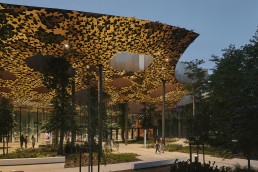
House of Hungarian Music, Budapest, Hungary
Sitting in harmony with the surrounding parkland, the new House of Hungarian Music is a glimmering, ambitious new building. Fixtures from Erco help bring this new cultural forum to life.
Nestled like a futuristic, oversized mushroom in the Városliget forested park of Budapest lies the House of Hungarian Music. Designed by Japanese architect Sou Fujimoto, the House of Hungarian Music is one of the most spectacular new buildings of the “Liget Budapest Project” – an ambitious cultural forum with numerous museum buildings being built on obsolete, unused sites.
Spanning 836sqm, the music pavilion combines various exhibition and event spaces, offices, a library and two outstanding concert halls under a projecting, organically curved roof structure.
The pavilion was designed with the intention of redefining the boundaries between indoors and outdoors, between architecture and nature – through its weightless design, visitors could believe themselves to be in a clearing in the middle of the forest. Its striking canopy structure, supported by elegant pillars, is perforated by 100 crater-like cavities – through which trees grow, enhancing the connection to the surrounding park.
The transparent architecture was the determining parameter for the lighting concept; Erco downlights were installed in the glazed pavilion to avoid glare and disruptive reflections, ensuring maximum visual comfort.
In the foyer, with a ceiling decorated by 30,000 specular gold leaf-like ornaments, 350 Erco Gimbal recessed spotlights provide glare-free general lighting. The Gimbal luminaires, with focused light, imitate the incidence of natural light rays without illuminating the leaf ornaments themselves. This enables the luminaires to be precisely aligned to the gaps in the complex ceiling structure.
With a ceiling height of 12 metres, precisely directed light is essential, preventing light spill and reducing energy wastage. Erco’s luminaires function with projecting optical systems that direct the light with high precision, achieving high illuminance levels from large distances, even with a low connected load. This creates the basis for sustainable lighting, in which light is only used where it is needed.
In the basement, a permanent interactive multimedia exhibition documents the history of European and Hungarian music. Here too, high rooms characterise the architecture. The exhibition, as well as numerous screens in the exhibition areas, also had to be taken into account in the lighting concept. Erco’s Optec spotlights for track were used, as they provide precisely accentuated lighting, even at a room height of seven metres.
Outside, lighting had to comply with strict regulations against light pollution – neither trees nor sky could be directly illuminated in the park. As such, 100 Erco Tesis ground-recessed luminaires illuminate the gold leaf canopy of the glazed foyer from outside, providing poetic indirect lighting. The precisely directed light always remains below the roof construction, without causing any unnecessary light pollution.
With playful ease, the glass pavilion succeeds in creating a symbiosis between architecture, light, music and the urban woodland. Just a few minutes’ walk from the Budapest city centre, the House of Hungarian Music represents a fabulously different and sonically inspiring world.



